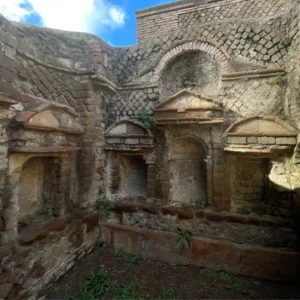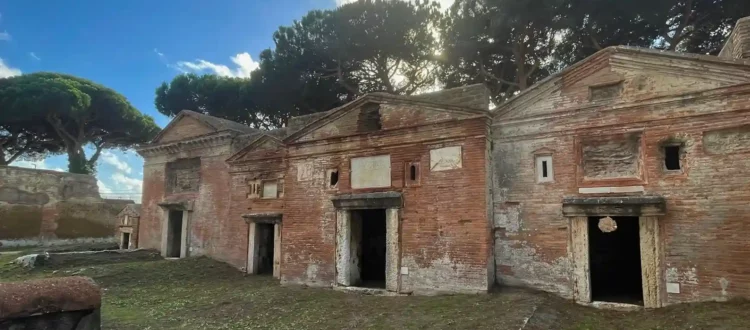The Necropolis of Portus: The Ancient Cemetery of Isola Sacra
Located along the Lazio coast, Fiumicino is not just a transit hub for travelers from around the world, thanks to Rome’s Leonardo da Vinci International Airport, but also a place rich in charm and tradition.
This small seaside town boasts a remarkable history, as evidenced by its significant archaeological finds and monuments.
Today, we invite you to discover the Necropolis of Portus, a hidden gem of the area, little known even to those living in Rome and its surroundings.
To reach it, simply follow the signs to Isola Sacra, a quaint district of Fiumicino with an evocative name.
Despite its name, it is not an actual island but a stretch of alluvial land formed by sediment deposits from the Tiber River, bordered by two of its branches and the coastal line.
The term “sacred” likely originates from the ancient presence of funerary areas and places of worship in this area.
The Discovery of the Necropolis of Portus in the Isola Sacra
 The Necropolis of Portus was discovered by chance, much like many other archaeological sites in Italy.
The Necropolis of Portus was discovered by chance, much like many other archaeological sites in Italy.
It was during the 1920s, under Fascist rule, a period marked by large-scale land reclamation projects across the country. At that time, Isola Sacra was a swampy and unhealthy region, prone to frequent flooding by the Tiber and the sea.
During the drainage and land preparation works, laborers unearthed the remains of sepulchral buildings decorated with paintings, stuccoes, and mosaics.
A thick layer of marine sand had buried the area, preserving the artifacts from destruction.
This accidental find led to the rediscovery of the vast sepulchral site of the Necropolis of Portus, forgotten for centuries and absent from historical records.
The following years were crucial: excavation campaigns intensified, and by the 1930s, the true nature of the necropolis began to emerge.
Archaeologists discovered that the tombs were arranged along a Roman road linking the Ports of Claudius and Trajan to Ostia and, ultimately, to Rome. This road, used for centuries as a main thoroughfare, was flanked by the graves of families and workers connected to the port’s activities.
The Tombs and Monuments of the Necropolis of Portus
 Imagine walking along the ancient paving stones of the Via Flavia-Severiana, a road once teeming with life, connecting the grand ports of Claudius and Trajan with Ostia, Rome’s primary commercial port at the mouth of the Tiber.
Imagine walking along the ancient paving stones of the Via Flavia-Severiana, a road once teeming with life, connecting the grand ports of Claudius and Trajan with Ostia, Rome’s primary commercial port at the mouth of the Tiber.
From a distance, you can feel the sea breeze carried by the wind.
Along this route stand the tombs and funerary monuments of the Necropolis of Portus, a burial site that tells the stories of those who lived and worked in the area.
The grandest and most majestic tombs, often meant to house entire families, are true monuments standing out in the landscape, designed to preserve the memory of the deceased for eternity.
These chamber tombs feature a two-story layout, covered with barrel vaults or flat terraces. On their facades, inscriptions in Greek or Latin reveal precious details: the owner’s name, the dimensions of the tomb, and even the deceased’s last wishes.
Beside the inscriptions, decorative bricks and terracotta reliefs depict scenes from the daily lives of the deceased, paying tribute to their professions and identities.
For example, at the entrance to Tomb No. 100, you can see a midwife assisting a woman about to give birth. This is Scribonia Attice, a midwife who died in the early Antonine era. Beside her is her husband, Marcus Ulpius Amerimnus, a surgeon depicted performing an operation on a patient’s leg.
Another tomb, No. 78, offers a glimpse into the life of a miller: a terracotta relief shows a millstone operated by a blindfolded horse, symbolizing the manual labor and daily toil that sustained Portus’ commerce and economy.
Not all tombs boast such opulence.
Next to the monumental graves are smaller ones for individuals who could not afford large expenses. For those with even fewer resources, a dedicated area called the “field of the poor” was reserved. Archaeologists identified this section due to its high concentration of modest burials, including tile-covered tombs (tomba a cappuccina), amphora graves, and simple earth burials marked only by humble funerary steles.
This variety of tombs reflects the social stratification of Portus’ community.
Among merchants, freedmen, small entrepreneurs, and artisans, the stories of a hardworking middle class emerge, alongside those living on the margins. Together, they provide a vivid, comprehensive picture of Roman society.
Practical Information for Visiting the Necropolis of Portus
How to Reach the Necropolis of Portus from the Rome Airport Inn
The entrance to the Necropolis is located at Via Monte Spinoncia 52, just 4.5 kilometers from the Rome Airport Inn.
- By Car:
Follow the signs for Via della Scafa. Enter Via della Scafa and, upon reaching the roundabout, continue straight onto Via Redipuglia. After about a kilometer, turn right onto Via Plava, leading you to the archaeological site’s entrance.Travel time by car: Approximately 10 minutes.
- By Bike:
The flat terrain makes for a pleasant walk or bike ride if you have extra time and want a more immersive experience.
At our B&B, we offer two e-bikes with pedal assistance for your convenience!
Opening Hours of the Necropolis of Portus
The archaeological area is open to the public during the following hours:
- Tuesday to Sunday: 10:30 AM to 4:30 PM (last entry at 4:00 PM).
- Closed on Mondays, January 1st, and December 25th.
Ticket Prices
- Full Price: €6
- Reduced: €2 (for EU youth aged 18–25).
For information:
Phone: 06 6583888 or 06 56358099 (switchboard).
Site staff provide visitor orientation and assistance.










